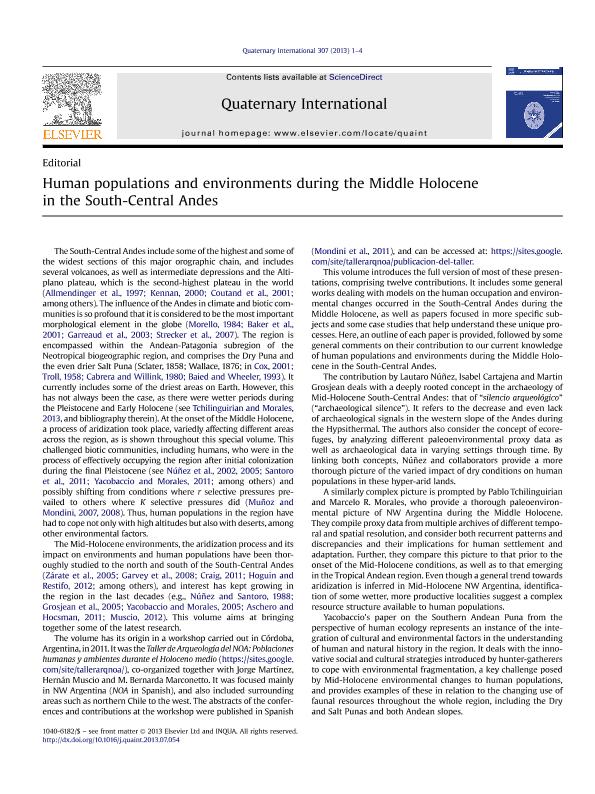Artículo
Human populations and environments during the Middle Holocene in the South-Central Andes
Fecha de publicación:
09/2013
Editorial:
Elsevier
Revista:
Quaternary International
ISSN:
1040-6182
Idioma:
Inglés
Tipo de recurso:
Artículo publicado
Clasificación temática:
Resumen
The South-Central Andes include some of the highest and some of the widest sections of this major orographic chain, and includes several volcanoes, as well as intermediate depressions and the Altiplano plateau, which is the second-highest plateau in the world (Allmendinger et al., 1997; Kennan, 2000; Coutand et al., 2001; among others). The influence of the Andes in climate and biotic communities is so profound that it is considered to be the most important morphological element in the globe (Morello, 1984; Baker et al., 2001; Garreaud et al., 2003; Strecker et al., 2007). The region is encompassed within the Andean-Patagonia subregion of the Neotropical biogeographic region, and comprises the Dry Puna and the even drier Salt Puna (Sclater, 1858; Wallace, 1876; in Cox, 2001; Troll, 1958; Cabrera and Willink, 1980; Baied and Wheeler, 1993). It currently includes some of the driest areas on Earth. However, this has not always been the case, as there were wetter periods during the Pleistocene and Early Holocene (see Tchilinguirian and Morales, 2013, and bibliography therein). At the onset of the Middle Holocene, a process of aridization took place, variedly affecting different areas across the region, as is shown throughout this special volume. This challenged biotic communities, including humans, who were in the process of effectively occupying the region after initial colonization during the final Pleistocene (see Núñez et al., 2002, 2005; Santoro et al., 2011; Yacobaccio and Morales, 2011; among others) and possibly shifting from conditions where r selective pressures prevailed to others where K selective pressures did (Muñoz and Mondini, 2007, 2008). Thus, human populations in the region have had to cope not only with high altitudes but also with deserts, among other environmental factors.
Palabras clave:
Arqueología
,
Andes
,
Holoceno Medio
,
Ambiente
Archivos asociados
Licencia
Identificadores
Colecciones
Articulos(IDACOR)
Articulos de INSTITUTO DE ANTROPOLOGIA DE CORDOBA
Articulos de INSTITUTO DE ANTROPOLOGIA DE CORDOBA
Citación
Mondini, Nora Mariana; Human populations and environments during the Middle Holocene in the South-Central Andes; Elsevier; Quaternary International; 307; 9-2013; 1-4
Compartir
Altmétricas




